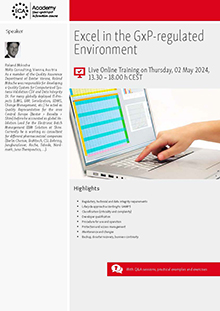Recommendations of the EMA for the risk assessment of metallic impurities in approved drugs

Recommendation
Thursday, 2 May 2024 13.30 - 18.00 h
Recently, with the inclusion of the Guideline ICH Q3D in the collection of "Scientific Guidelines", the EMA established the deadlines for its entry into force (see our news "The CHMP adopts the Guideline ICH Q3D as a 'Scientific Guideline'" of 21 January 2015). For drug producers, there is a relatively short transition period of 20 months to implement the requirements of the ICH Q3D; as of December 2017, the provisions for approved medicines will be mandatory.
On 27 March 2015, the EMA published a document entitled "Elemental impurities in marketed products. Recommendations for implementation". The targeted audience of these recommendations are pharmaceutical companies and the national regulatory authorities; the latter are to conform their activities to these recommendations in order to ensure a uniform approach. This should also reduce the workload in the processing of variations, which will then be evaluated according to the same criteria.
The main points of the "recommendations" are as follows:
- Each national authority should officially inform the drug companies (manufacturing authorisation holders; MAH) in their country of the application of the provisions of Guideline ICH Q3D.
- Within the transition period, the drug manufacturer should perform a risk assessment of his products in terms of elemental impurities. In doing so, all potential sources, such as starting materials for active substances, excipients, reagents, catalysts, process water, equipment, container closure systems, etc. are to be taken into account. This risk assessment should provide the basis for a control strategy that ensures that the respective permitted daily exposure limits (PDEs) specified in the guideline are adhered to.
- In all cases, a thorough risk assessment is to be conducted, which should be available to be presented during an inspection upon request.
- The application for a variation at the regulatory authority is not required if a risk analysis has shown that
- no further monitoring for elemental impurities in starting materials, intermediates, active ingredients, excipients and finished products is required, and that these do not have to be replaced or exchanged for others,
- no change in the manufacturing process is necessary. In all other cases, proceed as described in the variations regulation and the corresponding variation guidelines. - For the analyses of elemental impurities, specific procedures are to be used. Non-specific pharmacopoeia methods will not be accepted.
It remains to be seen whether these recommendations will result in a standardised approach of the authorities of the EU Member States and how the pharmaceutical manufacturers will be supported in their efforts of a timely implementation of the requirements of the Guideline ICH Q3D. An article by the "Industry Coalition" in the March issue of the magazine "Pharmaceutical Technology Europe" which provides practical suggestions for conducting risk assessments is also very helpful in this context.
Related GMP News
GMP Conferences by Topics
- General Quality Assurance and GMP Compliance Topics
- Hygiene
- General Microbiology Topics
- Regulatory Affairs
- Development
- General Analytics Topics
- Good Distribution Practice
- Sterile Manufacturing
- Computer Validation
- General Qualification/Validation Topics
- General Engineering Topics
- APIs/Excipients
- GMP Basic Training Courses
- Medical Devices and Combination Products
- Packaging and Packaging Material
- Data Integrity
- Qualified Person (QP)
- GMP Auditing
- Documentation
- Cleaning Validation
- General IT Compliance Topics
- Impurities
- OOS / OOE / OOT
- Material Testing
- Validation of Analytical Methods
- Analytical Instrument Qualification
- Stability Testing
- Microbiological Testing
- Technology
- General Manufacturing Topics
- Solid Dosage Forms/Semi-Solid Dosage Forms
- Biotechnology/Blood/ATMP
- Herbal Drug Products/Cannabis/Radiopharmaceuticals
- Others




